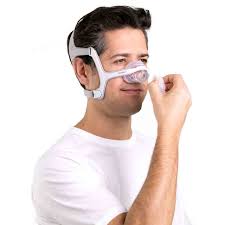Selection of the right mask for delivering PAP therapy for treating OSA is very important for good compliance to PAP treatment. There are different types of masks available to deliver PAP therapy-
- Nasal mask
- Oro-nasal mask. Also known as Full face mask.
- Nasal pillows
- Total face mask
- Oral mask- Least used for treating OSA.
Patient should be given a trial of each mask so that they can experience how they feel using each mask type and which mask is most comfortable for them. We should help the patient to find the right fit of the selected mask to set up for a successful therapy. We should also help the patient to understand that there are differences in clinical outcomes between nasal mask/nasal pillows versus oro-nasal masks.
Different manufacturers provide mask sizing gauges with each mask type to find the right fit for the mask. Sleep lab should have all the mask sizing gauges from different manufacturers for different masks.
Few manufacturers have launched their own mask sizing and fitting apps which scan the face of the patient and make manufacturer specific recommendations for the best fitting mask. Fisher and Paykel have launched one such app called “F&P mymask” (https://www.fphcare.com/us/my-sleep-apnea/products/mymaskapp/). No additional hardware is required along with the app. The recommendations made by “F&P mymask” are manufacturer specific. It also provides step-by-step instructions for fitting, cleaning, and fine-tuning your mask. It also includes troubleshooting advice.
Philips have also launched a 3D scanner camera to scan the patients face to recommend the right mask for the patient. But the recommendations made are manufacturer specific and they have not made it available in an app format. One need to have hardware (3D scanner camera) manufactured by Philips to use this option. Also, it’s not available in every country. please check with Philips Respironics representative for more details with regards to your country.
Resmed also launched a digital tool to help do mask fitting remotely. Resmed mask selector works this way- An HME provider provides a HIPAA-compliant single-use link via text or email to a patient, who then answers a brief questionnaire and enters three facial measurements into the ResMed MaskSelector portal; based on the patient’s responses, the tool recommends one of ResMed’s masks, along with options for alternative ResMed mask models and sizes. It’s not freely available for clinicians or patients to use it on their own. We need to go through a RESMED distributor to access this service. Also, it’s not available in every country. Please check with RESMED representative for more details with regards to your country.
I feel artificial intelligence can play an important role in mask sizing and fitting. One such app which uses AI is Maskfit AR. This app uses artificial intelligence (AI) and machine learning to help you find the best-suited CPAP or BiPAP mask. It uses a large database of mask measurements, as well as facial, demographic, clinical, and satisfaction data. You can download the app for free on the App Store or Google Play. It works with any smart phone or tablet and no additional hardware is required to make it work. one can register as patient or as clinician and company approaches you via email for account set up. Check more details on their website (https://www.maskfitar.com). Maskfit AR scans the face and make suggestions for best fitting mask from different manufacturers. This is a good feature as this allows the patient to chose the best available mask from different manufacturers. But I have not seen any validation study showing the effectiveness of suggestions made by this app versus mask fitting done manually by sleep technologist using different sizing gauges.
Company specific apps or AI based apps make recommendations from already manufactured masks of different sizes. Most of the research done by manufacturers for sizing the masks is done on western faces while Asian faces are very different from western population. I think that scanning the face and 3D printing the mask will fit the mask in best possible way.
A recent observational study have provided the proof of this concept in OSA patients who were having poor compliance to CPAP therapy (https://doi.org/10.5664/jcsm.11340). Patients’ facial topography was mapped using a series of photographs obtained using a camera (Nose Studio, Bespoke Medical Innovations Pty Ltd, Castle Hill, Australia) to render a 3D profile of the nose. A novel 3D-printed CPAP nasal mask (Apnea- Seal N1, Bespoke Medical Innovations Pty Ltd) was fabricated for each patient based on their 3D facial scan. Patients with customised mask used the CPAP therapy for 85.7% of the nights whereas patients using conventional mask used CPAP therapy for only 63.2% of the nights. Patients with customised mask used the CPAP therapy for 3.8hrs per night whereas patients using conventional mask used CPAP therapy for only 2.4hrs per night. Patients preferred the customized mask and reported less mask-related side effects. This approach is more useful for improving compliance to CPAP therapy but the business side of it has complex logistics to make it available on mass scale.

